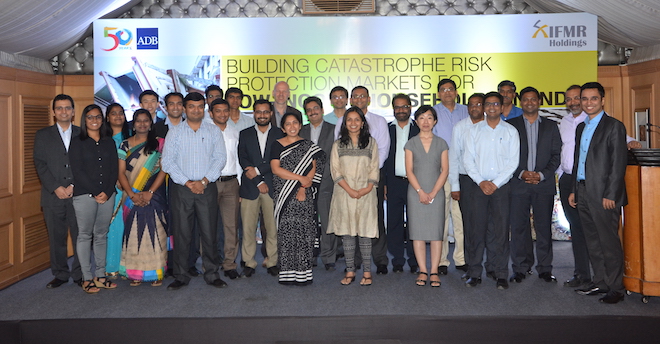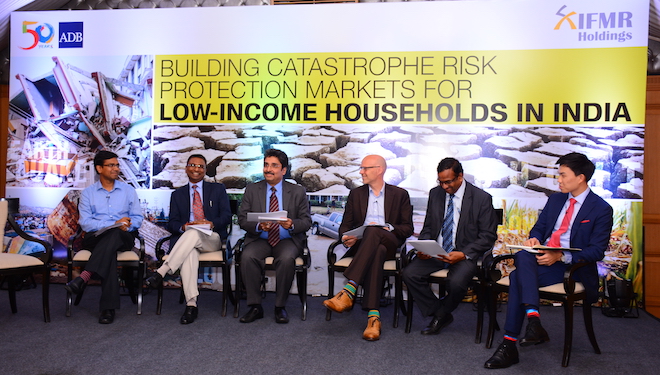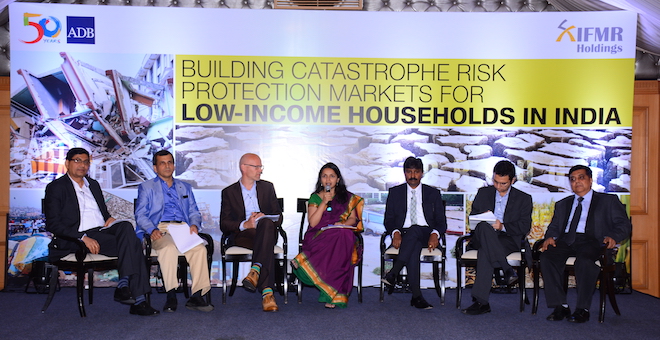Natural catastrophes, whether in the form of the severe drought that regions like Bundelkhand are currently witnessing or floods, like the one which deluged Chennai in 2015, leave behind them a tale of destruction that is both unparalleled and deeply disturbing. Natural disasters cost India $3.3 billion in 2015[1], the figure not accounting a crucial factor – “loss of livelihood”.
Amongst the ones who are hit during a natural catastrophe, the impact is most severe on low-income households and ones living below-the-poverty line. Natural disasters such as floods, droughts, cyclones and earthquakes keep pushing a majority of these households back, curtailing their attempts to move to a higher financial path every time such a catastrophe strikes.
According to a report, “An annual global investment of $6 billion in disaster risk management strategies would generate total benefits in terms of risk reduction of $360 billion“[2] (suggesting a 1:60 ratio of cost to benefit) but sadly it adds that this is equivalent to just a 20% reduction of new and additional annual economic losses due to natural disasters. In the Indian context, as a nation we will be spending close to $9 billion over the next 5 years towards disaster risk management, but the question remains, is that enough?
While government expense on disaster management will surely mitigate the effects of disasters in terms of preparedness, but how does one go beyond the insured assets and insured lives, particularly given that insurance penetration is very poor, especially in low income groups?[3] Solutions for the low-income household and business should not only insure hitherto uninsurable assets, uninsured lives, but also protect livelihoods and income streams.
With an endeavour to think through the challenges & opportunities that catastrophic risk entails and take the first steps in finding a solution to protect low-income households in India from the aftermath of natural catastrophes, Asian Development Bank & IFMR Holdings organised a joint workshop on June 2-3, 2016 towards this. The workshop brought together high quality originators, data scientists, climatologists, insurers, reinsurers, social impact investors and the regulator under one roof.

Finding a solution to protect customer households and businesses as well as the originators that have a relationship with such households and businesses was the imminent theme of this workshop. “What we can think of, we can do”, as Sucharita Mukherjee, CEO of IFMR Holdings put it, was the underlying spirit that drove the particiapnts. Delivering the keynote address P.J. Joseph, Member, Non-Life, Insurance Regulatory and Development Authority of India (IRDAI), very clearly suggested how insurance penetration continues to be extremely low – only 0.9% of GDP is protected by non-life insurance. He added how only 8% of economic losses were insured and thus there was a need for out of the box solutions for catastrophe risks. The premium collected by the non-life industry for natural catastrophes amounted to about INR 4,500 crore annually whereas the loss from the Chennai floods alone stood at about INR 14,000 crore said R. Chandrasekaran, Secretary General, General Insurance Council, in his opening address. He added, although tax rebates initially helped give impetus to product take-up, today tax rebates are not the foremost reason why people buy health insurance, a similar approach might be worth considering for catastrophe protection covers.
Udaya Kumar, MD and CEO of Grameen Koota, in his talk highlighted the difference an ideal natural catastrophe protection solution can bring to the lives of low-income customers served by his organisation. He expounded on how natural catastrophes initiate vicious cycles of poorer life to the already poor and how a safety net provided by catastrophe insurance can make clients more resilient and aid the organisation’s efforts on financial inclusion.
Bama Balakrishnan, CRO of IFMR Capital later shared analysis of how some of the originators had medium to very high risk exposure to their net worth owing to catastrophe risk and how this continues to be a barrier to financial inclusion, keeping originators away from high risk prone geographies.
In addition to having specialists present their insights on key issues and participants engaging themselves in group discussion on key themes, the workshop also provided for a couple of panel discsussions.

The first panel discussion was on the different types of catastrophe risk protection products that exist globally and in India. In addition the panel deliberated on what are the data, risk models and loss curves available and how can these be improved? The panel consisted of Dr. Murthy Bachu, Principal Hydrologist at AON Benfield Analytics, Alex Chen, CEO of Asia Risk Transfer Solutions (ARTS), Ulrich Heiss, Senior Advisor, Sector Project Insurance at GIZ, Pushpendra Johri, VP of Risk and Insurance at RMSI, Vineet Kumar, Head Cat Perils Asia at SwissRe, in a discussion moderated by Arup Chatterjee, Principle Financial Sector Specialist, Sustainable Development and Climate Change Department at the Asian Development Bank (ADB). Key learnings from the panel:
- Natural catastrophe risk has been a subject under discussion in India for more than two decades; lack of robust data, event curves and loss models have prevented the development of holistic solutions, said Arup Chatterjee. The wait for perfect data might never be over, but there already exists a large understanding by data scientists and climatologists that is more than sufficient for natural catastrophe-specific products in India.
- Pushpendra Johri suggested availability of flood model based on 50 years of river flow data and 109 years of rainfall data with RMSI. He added that there is enough data to begin, but data reporting in the future will be a key game changer to make products more affordable in the long-run.
- Affordability is crucial; but one should also examine incentive-alignment of various stakeholders within a value chain to arrive at innovative ways of structuring the product premium payment. In one such example, while the cotton farmer is the end recipient within the value chain, it is the cotton buyer who pays for the premium. The increase in cotton produce directly affects the buyers business and a more resilient farmer means higher profit for the buyer entities.
- Role of technology in e-delivery needs to be explored against best practices around the world and new innovations waiting to emerge.
- A good starting point appeared to be in the form of a parametric insurance product that transcends the exposure only to assets and looks at items like loss of income and livelihood as the important factors in deciding the amount of insurance cover.
- With a deep understanding of their customer needs, geographically specialised originators like microfinance institutions, small business lenders, affordable housing finance institutions and similar institutions in financial inclusion are aware of the impact of natural disasters on the lives and livelihood of their customers’ in absence of any financial protection.
- Catastrophe risk affects credit markets including interest rates, losses on loan causes capital erosion for financial institutions. Re-capitalising and de-leveraging are two options in the aftermath of a disaster, though both with their negatives. Recapitalisation is not so forthcoming and deleveraging affects the financial institution’s capability to lend. Residual risk management can be supplemented by catastrophe risk insurance products. Insurance and re-insurance play an important role in the underlying catastrophe risk – linking credit, risk and savings can result in appropriate risk financing strategies said Christine Engstrom, Director, Private Sector Financial Institutions, Private Sector Operations Department of ADB.
- Originators acknowledged the geographical risk they carry at an organisational level for operating in such markets and lending to customers highly exposed to natural disasters.

Another star panel moderated by Sucharita Mukherjee, which had Brahmanand Hegde, MD and CEO of Vistaar, Udaya Kumar, Vaibhav Anand, Head Risk Analytics and Modelling of IFMR Capital, Easwar Narayanan, COO of Future Generali, K. Venkatesh, CEO of IFMR Rural Channels, and Ulrich Hess deliberated on informal ways of managing risk by low-income households like income diversification, investing in gold (especially in South India), and investing in other assets like land. Key learnings from the panel:
- The poor are much more risk resilient than what one can imagine and their ability to bounce back is very high if supported by the right tools, said Udaya Kumar. A catastrophe insurance product could just be that tool.
- Greater concentration on a quick loss assessment and claim settlement is important.
- Simplicity of the product cannot be over-emphasized, element of instant relief to the affected households will make it more receptive.
- Customer contact post disaster is very important as the customer’s trust in the entity that serves them is critical.
- One of the insurer panellists asked, “Why do people insure motor and health?” the group unanimously agreed that a large reason is that people feel the immediacy of the loss.
- Idiosyncratic risks are much easier to perceive and customers avoid planning for more systemic risks like disasters world over.
- Awareness programs can make a difference. Examples cited suggest that campaigns that continued for multiple years saw much higher uptake in other insurance schemes, as signs of losses emerged and more customers realised its value.
- The use of technology for loss estimation – innovation at delivery and claim settlement can also be a game changer in faster and more accurate claim settlement. For example, if parameterised products are more cost effective than indemnity products, how can technology magnify the intelligence of the indices that parametric products are dependent on? Technology can have a role to categorise the income classes and the duration of the loss of income by studying these models and adding that to the index can be one such way as pointed by one of the panellists. Left to the customer for what cover to choose, they will always choose the cheapest product and hence intelligent indexing can be of good use.
- Can the government and CSR activities of institutions contribute to a risk fund? Participating Development Finance Institutions (DFIs) committed their support in running pilots, building better risk and loss models and further in normalising prices in the short run with a goal to make the product affordable.
- One of the points that came to the fore is that financial institutions are reluctant to sell these kinds of products – but the panel agreed that the profitability cannot be measured for each product line and as long as the product enhances customer resilience – the indirect beneficiary is the institution the customer borrows from.
Armed with all the inputs from the speakers and the panellist the entire group spent the first half of the second day working in multiple small groups to come up with product pilot ideas. It was as if all the participants had taken upon themselves to forge a definite way forward and so it was.
The group agreed upon critical design parameters for the pilot:
- Simple to buy (could cover multiple perils, with simple options, structure could be parametric / indexed).
- Affordable – capturing the pricing benefit of risk-pooling between different entities and different household profiles.
- The magnitude of the cover should provide for the loss of assets, loss of livelihood, and a buffer at an organisational level to meet unplanned exigencies or provide for households who were affected but couldn’t get compensation since parametric solutions will carry basis risk (may not cover all actual damages).
- The loan amount can be used as a proxy to determine the magnitude of cover.
- To design the vulnerability index that can be used to determine the value of cover (one may need a pre-survey to arrive at such a vulnerability index), pre-defined hazard and loss triggers.
The group, including originators unanimously agreed to build protection for catastrophe risk and were ready to be a part of joint initiatives to bring some of the solutions to light.
—
[1] http://www.firstpost.com/india/natural-disasters-cost-india-3-30bn-in-2015-heres-why-we-should-be-very-worried-2622940.html
[2] http://timesofindia.indiatimes.com/india/Disasters-cost-India-10bn-per-year-UN-report/articleshow/46522526.cms
[3] http://timesofindia.indiatimes.com/business/india-business/Insurance-penetration-in-India-at-3-9-percent-below-world-average/articleshow/46518607.cms



